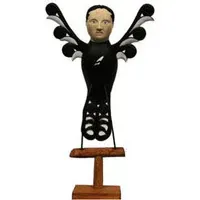Household Gods: Harry Watson
Written by

Mark Amery ponders the meaning of Christmas trees and "the gorgeously awkward, pensive, almost Germanic wooden figures of Wairarapa artist Harry Watson".
Courtesy of The Dominion Post
Image: William Wakefield, The Magpie, 2006,
Harry WatsonMark Amery ponders the meaning of Christmas trees and "the gorgeously awkward, pensive, almost Germanic wooden figures of Wairarapa artist Harry Watson".
Courtesy of The Dominion Post
Image: William Wakefield, The Magpie, 2006,
Harry WatsonThis is a time of the year when we consider our household gods and what they mean to us. What icons we invest worth in - be it a new dishwasher or a treasured fireplace nativity scene. Whether or not you're Christian, Christmas probably functions for you as a stock-take of who and what is of value and why.
I've been trying to make sense of what the Christmas tree and the angel atop it represent beyond tradition. I figure that, in a country that has been subject to enormous forest clearances and extinction of bird species since settlement, there's something commemorative of loss in the planting, cutting down and then decoration of pine trees. The Christmas tree only became popular in England at about the time of European settlement here. Popularised by Prince Albert and Queen Victoria from the German tradition, by the 1870s it was common for the top of the tree to be decorated with a Union Jack.
All these thoughts circle as I look at the gorgeously awkward, pensive, almost Germanic wooden figures of Wairarapa artist Harry Watson in his first solo exhibition in Wellington at Tinakori Gallery.
Watson's figures resemble idols for a table or feature wall in a home. Yet I say awkward and pensive because they have a powerful air of disquiet. They turn on the complications of venerating history and idols, and our relationship in the present with the colonial foundation they represent.
Like representations of angels from Medieval or Renaissance art, they resemble guardians or totems. In their chunky chiselled rotundity you might be reminded of the bust or figurehead that graces an old sailing ship's prow - representing the spirit of a home. They have the halfway look of elaborate carved furniture decoration by a settler craftsman, designed to act as talismans.
In Watson's work, however, leading figures like Edward Gibbon Wakefield (Director of the New Zealand Company) and Joseph Banks are represented absurdly, given wings as if taking flight. They are part satirical figures - represented as foreign meddling gnats - part playing out romanticised public roles as angelic-like intermediaries; like our Christmas angels they could be seen as virtuous messengers for God, missionaries for a new order.
In a work like 'The Fly Catching Macaroni (Joseph Banks)', in which Banks is shown trying to catch a butterfly with a net, the work's comment is less complex (and less successful artistically for it). Watson directly acknowledges a late 18th century popular etching which labels the botanist a 'macaroni' ( slang for a tourist) and sees him God-like striding across the globe cataloguing.
In another print of that era Banks was portrayed as an imperial caterpillar turning into a butterfly on a shoreline of the Pacific. In a small, strange surreal-like painting in this exhibition, 'Joseph Banks and the Fortune teller,' Banks' is a head atop the roots of a plant, floating in the air like a weird alien jellyfish. This creature is in exchange with a skeletal bird-headed tohunga in a pool, who is perhaps foretelling the death of most of the country's indigenous species.
These are not then simple objects of devotion. At their best they are complex hybrids, magpie-like borrowing costumes and badges that confuse different representations of nationhood, and wear as broaches indigenous and invasive foreign flora alike. They open up an uneasy complicated relationship with this country's colonial past.
Adding to the drama is sense the unease of the individuals themselves. There's an edge of the grotesque, and pain in the beady pupils of each set of eyes that puts you to attention. It's as if they're stuffed (hence perhaps their cherubic chubbiness), propped up on a pedestal in a museum, the equivalent of birds in cages.
Watson's focus isn't however just on history's protagonists. In one suite of works the busts of four Victorian women are presented. Emphasising the uncomfortable absence often of women in our told history (they have for me the pale anxiety and eyes of loss of the figures of Piero Della Francesca), their settings resemble ornamental wooden recesses from an old residential hallway, as if asserting these women's place as the central pillars of their homes.
Less successful in this exhibition for me are Watson's attempts to create a setting or mis-en-scene through the provision of other figures or painted elements. Rather perhaps the strongest set of works here is a series of funereal-like vessels. Their round barrels are painted with a range of formal jackets and topped by the heads of introduced birds like the sparrow and starling.
Like the magpie-like figure of Wakefield they are reminiscent of ancient Egyptian Ba-bird figures, representations of the spirit as part human part bird. Like angels, Ba-bird figures represented the soul of the deceased. You also can't help but be reminded of the bird-human figures of Bill Hammond's work or Michael Parekowhai's sparrows. Then there's the bird-like Maori manaia figure chiselled into the stomach of one of these vessels, another intermediary between the physical and spiritual world. A reminder of the significance of birds in Maori folklore as messengers from the spirit world.
There's much whimsy in Watson's work but equally a dreadful haunting from what we as a country have lost.
What: To Catch a Butterfly, Harry Watson, until December 22
Where: Tinakori Gallery, Wellington